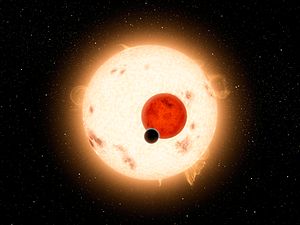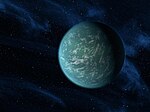克卜勒16b
| 太陽系外行星 | 太陽系外行星列表 | |
|---|---|---|
 | ||
| 母恆星 | ||
| 母恆星 | 克卜勒16 | |
| 星座 | 天鵝座 | |
| 距離 | 200[1] ly (61 pc) | |
| 軌道參數 | ||
| 半長軸 | (a) | 0.7048 ± 0.0011 AU |
| 軌道離心率 | (e) | 0.0069 ± 0.0015 |
| 公轉週期 | (P) | 228.776 ± 0.037 d |
| 軌道傾角 | (i) | 90.0322 ± 0.0023° |
| 物理性質 | ||
| 質量 | (m) | 0.333 ± 0.015 MJ |
| 半徑 | (r) | 0.22623 ± 0.00059 RJ |
| 密度 | (ρ) | 0.964 ± 0.047 g cm-3 |
| 表面重力 | (g) | 14.52 ± 0.7 m/s² |
| 溫度 | (T) | 170 - 200 K |
| 發現 | ||
| 發現時間 | 2011年7月7日 | |
| 發現者 | 勞倫斯·多伊[2] | |
| 發現方法 | 凌日法 (克卜勒太空望遠鏡) | |
| 發表論文 | Published | |
| 資料庫參考 | ||
| 太陽系外行星 百科全書 | data | |
| SIMBAD | data | |
克卜勒16b(Kepler-16b)是一個環繞食雙星的太陽系外行星,體積相當於土星。其組成成分可能是岩石和氣體各半[3]。這是首個確認的環聯星運轉行星[4][5],公轉週期229日[6]。
簡介
[編輯]
該行星是由NASA的克卜勒太空望遠鏡發現[7]。科學家發現到該行星通過聯星系統的其中一顆恆星前方,使其光度降低,但另一顆恆星光度卻未降低的情況,因而發現了它[7]。更進一步來說,該行星的凌日狀況允許科學家以極高精確度計算克卜勒16系統中天體質量[8]。發現該行星團隊的主持人,任職於加州山景城SETI中心的勞倫斯·多伊,形容其精確度是「我相信這是太陽系外測量精度最高的」(I believe this is the best-measured planet outside the solar system.)[8]。例如該恆星半徑的誤差值只有0.3%,直到2011年9月都是比其他系外行星誤差少[9]。
克卜勒16b是相當特殊的系統,因為該行星的軌道位於聯星系形成行星的軌道下限之內[8]。麻省理工學院的行星科學家薩拉·西格(Sara Seager)表示,在聯星系統中要有行星存在,行星軌道半徑必須是兩顆星距離的七倍以上才能形成穩定系統[8];但克卜勒16b的軌道半徑只有該推測距離的一半[8]。
該行星因為其表面溫度大約在-100到-70 °C之間,可能不適合生命生存。
從地球上觀察,克卜勒16b最快將在2014年對其中一顆恆星產生凌日現象,而在2018年對另一顆較亮恆星也發生凌日;之後直到2042年都無法以凌日法觀察它[8]。
名稱
[編輯]在公布這項發現的論文中,發現它的團隊表示,根據慣例[10],應該稱呼它 Kepler-16 (AB)-b,或者是在沒有歧義時只加上 「b」[1]。太陽系外行星百科將它稱為 Kepler-16 (AB) b[11]。SIMBAD資料庫稱呼它為 Kepler-16 (AB)-b[12]。
發現它的科學家非正式地以電影《星際大戰》中的虛擬行星塔圖因稱呼克卜勒16b[5] 。《星際大戰四部曲:曙光乍現》中,塔圖因上兩個太陽同時落下的場景相當有名[8]。而工業光魔的視覺特效總監,曾為多部電影製作特效的約翰·諾爾則說「再一次地,我們看到科學事實比小說更怪異」[8]。
參考資料
[編輯]
- ^ 1.0 1.1 Laurance R. Doyle, Joshua A. Carter, Daniel C. Fabrycky; et al. Kepler-16: A Transiting Circumbinary Planet. 2011. arXiv:1109.3432v1
 [astro-ph.EP].
[astro-ph.EP].
- ^ NASA - NASA's Kepler Discovery Confirms First Planet Orbiting Two Stars. [2011-09-15]. (原始內容存檔於2011-11-11).
- ^ Drake, Nadia. On Kepler-16b, shadows come in pairs. Science News. Society for Science & the Public. [16 September 2011]. (原始內容存檔於2012-08-28).
- ^ From Star Wars to science fact: Tatooine-like planet discovered. Smithsonian Science. The Smithsonian Institution. [24 September 2011]. (原始內容存檔於2011-09-24).
- ^ 5.0 5.1 Baldwin, Emily. Kepler planet circles two suns. Astronomy Now Online. Pole Star Publications Ltd. [16 September 2011]. (原始內容存檔於2012年8月28日).
- ^ Doyle, Laurance. First Planet Orbiting Two Stars Discovered by the NASA Kepler Spacecraft. The Huffington Post. 2011-09-15 [16 September 2011]. (原始內容存檔於2015-11-10).
- ^ 7.0 7.1 Gold, Scott. Scientists find planet orbiting two suns like in 'Star Wars'. Los Angeles Times. 2011-09-15 [16 September 2011]. (原始內容存檔於2011-09-18).
- ^ 8.0 8.1 8.2 8.3 8.4 8.5 8.6 8.7 Overbye, Dennis. NASA Detects Planet Dancing With a Pair of Stars. The New York Times. 2011-09-15 [16 September 2011]. (原始內容存檔於2011-09-16).
- ^ Winn, Joshua N.; Albrecht, Simon; Johnson, John Asher; Torres, Guillermo; Cochran, William D.; Marcy, Geoffrey W.; Howard, Adnrew W.; Isaacson, Howard; Fischer, Debra. Spin-orbit alignment for the circumbinary planet host Kepler-16 A. 2011. arXiv:1109.3198v2
 .
.
- ^ Hessman, F. V.; Dhillon, V. S.; Winget, D. E.; Schreiber, M. R.; Horne, K.; Marsh, T. R.; Guenther, E.; Schwope, A.; Heber, U. On the naming convention used for multiple star systems and extrasolar planets. 2010. arXiv:1012.0707
 .
.
- ^ Jean Schneider. Notes for Planet Kepler-16 (AB) b. Extrasolar Planets Encyclopaedia. 2011 [23 September 2011]. (原始內容存檔於2011年10月11日).
- ^ Object query: Kepler-16b on the online SIMBAD Astronomical database [1] (頁面存檔備份,存於網際網路檔案館)
外部連結
[編輯]- Kepler-16 (AB) at The Extrasolar Planets Encyclopaedia(頁面存檔備份,存於網際網路檔案館)
- Kepler-16: A Transiting Circumbinary Planet[永久失效連結], Laurance R. Doyle et al. 2011
- Spin-Orbit Alignment for the Circumbinary Planet Host Kepler-16A (頁面存檔備份,存於網際網路檔案館), Joshua N. Winn et al. 2011



